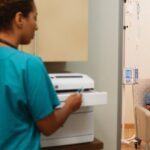The push to build vascular access teams in Ireland
Almost 50% of all reported cases of Staphylococcus aureus bloodstream infection (BSI) in the Irish hospital system are associated with intravenous (IV) catheters.1 A vascular access team (VAT) is made up of healthcare professionals (HCPs) “…whose primary role is to assess, insert, manage, perform surveillance, analyse the service data and solve clinical concerns and where possible remove vascular access devices (VADs).”2
VATs may increase first-stick success rates, while decreasing intravenous (IV) complications including infections.3
VATs in other countries have shown a positive impact on patient care.3
However, certain barriers such as a lack of funding, insufficient training or lack of awareness can impede progress in setting up this kind of team.3
Let’s take a close look at what’s going on in Ireland to facilitate the creation of VATs.
Vascular access teams start with infection prevention
In May 2023, the Antimicrobial Resistance and Infection Control Division (AMRIC) of the Ireland Health Service Executive (HSE) released its latest National Clinical Guideline No. 30 – Infection Prevention and Control (IPC) Full Report.4
The HSE manages all public health services across Ireland and has over 100,000 employees.5
This report provides guidance on infection prevention, including IV catheters care and maintenance best practices, to Irish healthcare professionals (HPCs).4
Although there is a recommendation on skilled inserters performing insertion on patients with difficult venous access (DIVA), the document does not offer specific guidance on how to implement and manage VATs.4
However, one of AMRIC’s 2022-25 strategic objectives is to “reduce the spread of infection and disease, through infection… prevention and control measures, including national guidelines and standards in relation to hygiene and biosecurity practices.”6
VAT development is one of the actions under this objective.6
More on this topic: New Spanish vascular access team standard
Department of Health funds the creation of vascular access teams
The AMRIC announced in April 2022, that the HSE would implement VATs in all nine model four hospitals and one model 3 hospital with funding from the Department of Health.1,7
Hospital models in Ireland8 |
|
| Model 1 | Community hospitals |
| Model 2 | Ambulatory care hospitals |
| Model 3 | General hospitals |
| Model 4 | Tertiary referral hospitals |
Model 4 hospitals provide acute and elective inpatient and ambulatory care, high-acuity procedures, cancer care, surgery, as well as emergency care.9
These are Ireland’s model 4 hospitals:9
- Beaumont Hospital
- Cork University Hospital
- Galway University Hospitals
- Mater Misericordiae University Hospital
- St. James’s Hospital
- St. Vincent’s University Hospital
- Tallaght University Hospital
- University Hospital Limerick
- University Hospital Waterford
AMRIC’s objective is to help reduce the incidence of IV catheter-related Staphylococcus aureus BSIs by standardising vascular access, care and maintenance.7
From 2022-25, the HSE is:6
- Reviewing the implementation of VAT pilot projects
- Supporting all the above hospitals in their efforts to set up a VAT
- Assessing the impact of these teams on reducing IV catheter-related BSIs
A symposium to drive awareness on importance of vascular access teams
In spring 2023, BD brought vascular access experts and Irish HCPs together at BD Intravenous Symposium Ireland.
During the day, they exchanged views on vascular access best practice.
The event was chaired by Andrew Barton, Nurse Consultant in vascular access and IV therapy and chair of the National Infusion and Vascular Access Society (NIVAS), who opened the event with a focus on VATs.
Last year, NIVAS published a white paper on VATs.
According to the white paper, “The advantages of a specialist team responsible for vascular access include better workflow with increased efficiency, reduction in infection rates, improved patient outcomes and quality of care.”3
Healthcare in the Republic of Ireland may see these benefits with the creation of VATs.
References
- Health Service Executive (HSE) Antimicrobial Resistance and Infection Control Team (AMRIC). PVC CVC guidance /IVC care teams update. RESIST. July 1, 2023:6.
- Carr PJ, Moureau NL. Specialized Vascular Access Teams. In: Moureau NL, ed. Vessel Health and Preservation: The Right Approach for Vascular Access. Springer International Publishing; 2019:59-65. doi:10.1007/978-3-030-03149-7_5
- Barton A. The Benefits of a Nursing Led Vascular Access Service Team: A White Paper to outline a standardised structure and approach for the NHS to deliver vascular access services in every hospital. Published online June 1, 2022. Accessed August 16, 2023. https://nivas.org.uk/contentimages/main/NIVAS-White-paper-for-standardisation-of-vascular-access-teams-within-the-NHS_FINAL-27.06.22.pdf
- Cormican M. National Clinical Guideline No. 30 – Infection Prevention and Control (IPC) Full Report. Published online May 1, 2023. Accessed August 16, 2023. https://www.gov.ie/en/publication/a057e-infection-prevention-and-control-ipc/#national-clinical-guideline-no-30-infection-prevention-and-control-ipc-full-report-volume-1
- Irish Health Service Executive (HSE). HSE Organisational Structure. Published 2023. Accessed August 10, 2023. https://www.hse.ie/eng/about/who/
- Irish Health Service Executive (HSE). HSE Antimicrobial Resistance Infection Control (AMRIC) action plan 2022-2025. Published online 2021. Accessed August 18, 2023. https://www.hse.ie/eng/about/who/healthwellbeing/our-priority-programmes/hcai/resources/general/hse-antimicrobial-resistance-infection-control-amric-action-plan-2022-2025.pdf
- Health Service Executive (HSE) Antimicrobial Resistance and Infection Control Team (AMRIC). PVC CVC guidance /IVC care teams update. RESIST. April 1, 2022:4.
- Irish Health Service Executive (HSE). Securing the Future of Smaller Hospitals: A Framework for Development.; 2013. Accessed September 8, 2023. https://assets.gov.ie/12170/91124d282ee84248b929698e050dedc5.pdf
- Irish Department of Health. Map of six new Regional Health Areas. Published online February 1, 2022. Accessed August 10, 2023. https://www.lenus.ie/handle/10147/631494
This list of references to third-party peer-reviewed material and the sites they are hosted on are provided for your reference and convenience only, and do not imply any review or endorsement of the material or any association with their operators. The Third-Party References (and the Web sites to which they link) may contain information that is inaccurate, incomplete, or outdated. Your access and use of the Third Party Sites (and any Web sites to which they link) is solely at your own risk.
BD-99542




